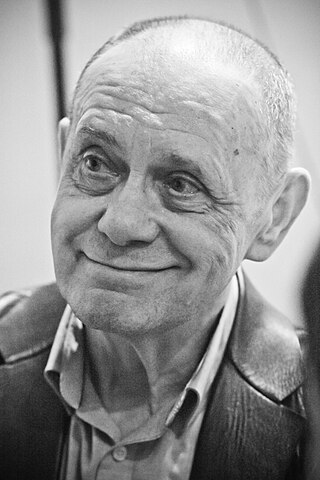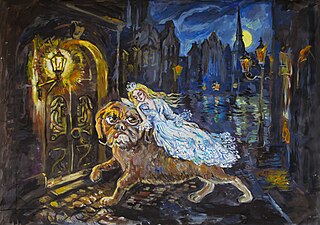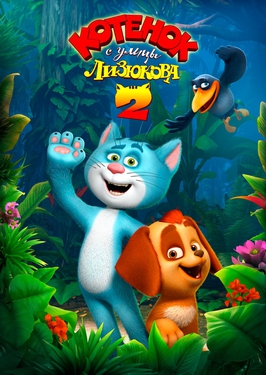
Soyuzmultfilm is a Russian animation studio based in Moscow. Launched on June 10, 1936 as the animated film production unit of the U.S.S.R.'s motion picture monopoly, GUKF, Soyuzmultfilm has produced more than 1,500 cartoons. Soyuzmultfilm specializes in the creation of animated TV series, feature films and short films. The studio has made animated films in a wide variety of genres and art techniques, including stop motion, hand-drawn, 2D and 3D techniques.

Garri Yakovlevich Bardin is a Soviet and Russian animation director, screenwriter, producer and actor best known for his experimental musical and stop motion films. He was awarded the 1988 Short Film Palme d'Or for the Fioritures cartoon and the Order of Honour in 2011.

"The Tinderbox" is a literary fairy tale by Hans Christian Andersen about a soldier who acquires a magic tinderbox capable of summoning three powerful dogs to do his bidding. When the soldier has one of the dogs transport a sleeping princess to his room, he is sentenced to death but cunningly summons the dogs to save his life.

Hoffmaniada is a 2018 Russian stop motion-animated feature film from Soyuzmultfilm. The film is one of the first full-length puppet animated film in the recent history of the animation studio. The concept and the art design was done by Mikhail Shemyakin and is edited by Stanislav Sokolov and Veronika Pavlovskaya, written by Sokolov and Viktor Slavkin, and directed by Sokolov.
![<i>The Snow Queen</i> (1957 film) 1957 [[Soviet Union]] film](https://upload.wikimedia.org/wikipedia/commons/thumb/4/46/1960_-_Earle_Theater_Ad_-_24_Aug_MC_-_Allentown_PA.jpg/320px-1960_-_Earle_Theater_Ad_-_24_Aug_MC_-_Allentown_PA.jpg)
The Snow Queen is a 1957 Soviet animated musical fantasy film directed by Lev Atamanov. It is the ninth full-length animated production by Soyuzmultfilm and is based on the 1844 fable “The Snow Queen” by Hans Christian Andersen. The film is one of the earliest cinematic adaptations of the Scandinavian Danish fable since its publication in New Fairy Tales. First Volume. Second Collection.
![<i>The Kitten from Lizyukov Street</i> 1988 [[Soviet Union]] film](https://upload.wikimedia.org/wikipedia/en/2/2b/Kitten_From_Lizyukov_Street_Film.jpg)
The Kitten from Lizyukov Street is a 1988 Soviet animated film directed by Vyacheslav Kotyonochkin of Soyuzmultfilm animation studio.

The Snow Queen is a 2012 Russian animated fantasy adventure film directed by Vladlen Barbe and Maxim Sveshnikov. The film is a based on the 1844 fairy tale of the same name by Hans Christian Andersen. Set after the Snow Queen invoked the spell of eternal winter, the film follows the story of Gerda who sets out on an improbable frigid journey up North to save her brother Kai.

Voronezh Animation Studio is a Russian animation film, short film and television studio based in Voronezh. The studio specializes in the production of animated feature films, television shows and their distribution and promotion in the domestic and international markets. The studio was formed in 2007 from a company specializing in software development, multimedia and software localization. Originally founded under the name InlayFilm, it rebranded as Wizart Animation in 2012. In August 2022, the company changed its name to Voronezh Animation Studio.

The Snow Queen 2, is a 2014 Russian animated fantasy comedy film directed by Aleksey Tsitsilin. It is the sequel to The Snow Queen (2012). The film follows the story of troll Orm who gets mired again in lies and financial irresponsibility after he sees a reflection while working as a miner. The vainglorious troll Orm gets a chance to become a hero again when the Troll King Arrog proclaims the decree that whoever rescues his royal family trapped at the palace of the Snow Queen will receive a grand prize.

The Snow Queen 3: Fire and Ice is a 2016 Russian animated fantasy adventure film directed by Aleksey Tsitsilin. It is the sequel to The Snow Queen 2 (2014). In the film, Gerda and her friends embark on a new journey to reunite her family.

Sheep and Wolves is a 2016 Russian animated fantasy comedy film, directed by Andrey Galat and Maxim Volkov. The original story, Wizart Animation's first, contains elements of the fairy tale The Wolf and the Seven Young Goats and the concepts of a wolf in sheep's clothing. It is about a carefree wolf who likes to hunt sheep, but one day finds that he has been magically transformed into a sheep himself.

The Snow Queen: Mirrorlands is a 2018 Russian animated fantasy adventure film directed by Robert Lence and Aleksey Tsitsilin. It is the sequel to The Snow Queen 3: Fire and Ice (2016). The film follows the war between magicians and technocrats.

Sheep and Wolves: Pig Deal is a 2019 Russian 3D animated fantasy-comedy film. The story is the sequel to original film Sheep and Wolves and contains the elements of the fairy tale The Wolf and the Seven Young Kids. Wizart Animation and CTB Film Company were joint animation production studios for the film that is produced by Sergey Selyanov, Yuri Moskvin, Vladimir Nikolaev and directed by Vladimir Nikolaev and Mikhail Babenko.

Space Dogs: Return to Earth also known as Space Dogs: Tropical Adventure is a 2020 Russian 3D animated comedy fantasy family film written by Danil Trotensko, Artem Milovanov, Mike Disa, Olga Nikiforova, Viktor Strelchencko and directed by Inna Evlannikova. The film was produced by Moscow studios KinoAtis and Gorky Film Studio. The creators from one of Russia's first national 3D animation studio rejoined to continue to animate the latest adventure of the canine heroes, Belka and Strelka.

Horse Julius and Big Horse Racing is a 2020 animated Russian folklore spin-off film written by Vadim Sveshnikov, Maxim Sveshnikov, Alexsandr Boyarskiy and directed by Darina Schmidt and Konstantin Feoktistov. The writers and producers of The Three Bogatyrs resumed production in the tenth film of the Russian animated saga. Veteran producers for the series as well as CTB Film Company, Sergey Selyanov and Alexander Boyarsky resumed production for the film. Horse Julius and Big Horse Racing is the sequel to Three Heroes and The Heiress to the Throne (2018) and is dedicated to the feats of the character Bogatyr horse Julius.

Secret Magic Control Agency is a 2021 English-language Russian animated comedy film directed by Aleksey Tsitsilin and written by Analisa LaBianco, Vladimir Nikolaev, Jeffery Spencer, Tsitsilin, and Alexey Zamyslov. Produced by Wizart Animation, CTB Film Company, and QED International, the film is a loose adaptation of the fairy tale Hansel and Gretel by the Brothers Grimm.

The Nose or the Conspiracy of Mavericks is a 2020 Russian animated film. The film is created by the animation studio School-Studio "Shar". People's Artist of Russia animator, Andrei Khrzhanovsky directed the film. The film is based on the Russian classic, The Nose by Nikolai Gogol. The script writers Yuri Arabov and Andrei Khrzhanovsky adapted the 19th-century prose of Gogol as well as the verses of the opera of the same name by Dmitri Shostakovich into an animated film featuring a mixture of drawings, cut-outs, live-action, and documentary style filming.

The Tales of Wonder Keepers is a 3D animated fantasy children's television series. The first season was co-produced by IQIYI and Wizart Animation and the later seasons were produced by the Chinese streaming platform, IQIYI. It was adapted from Hans Christian Andersen's fairy tale, The Snow Queen. The serial explores the adventures of the character Icy, the Snow Queen’s five-year-old daughter, who comes to the human world to live and explore the adventure with her new friends, Gerda and Kai. They experience amazing adventures in an enchanting new world full of mysteries, pirates, magicians, and even walking plants! In the face of difficulties, they turn into little superheroes, the Wonder Keepers, and overcome crises with the help of magic and science. They are fearless in protecting the town and fighting for justice. The series is currently streaming on iQIYI.

The Kitten from Lizyukov Street2 is a 2017 Russian computer-animated short film produced by Wizart Animation and directed by Alexey Zamyslov.

Ukrainian animation, which began in the late 1920s, is part of Ukrainian cinematography and has involved a variety of techniques, including frame-by-frame filming, time lapse, and computer animation.





![<i>The Snow Queen</i> (1957 film) 1957 [[Soviet Union]] film](https://upload.wikimedia.org/wikipedia/commons/thumb/4/46/1960_-_Earle_Theater_Ad_-_24_Aug_MC_-_Allentown_PA.jpg/320px-1960_-_Earle_Theater_Ad_-_24_Aug_MC_-_Allentown_PA.jpg)
![<i>The Kitten from Lizyukov Street</i> 1988 [[Soviet Union]] film](https://upload.wikimedia.org/wikipedia/en/2/2b/Kitten_From_Lizyukov_Street_Film.jpg)













